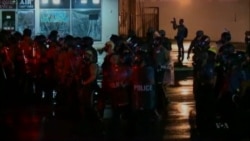U.S. lawmakers on Tuesday reviewed federal government programs that provide billions of dollars in surplus military weapons and equipment to civilian police departments.
The action comes amid growing calls to end the so-called "militarization" of local law-enforcement agencies after last month's police response to protests in Ferguson, Missouri.
Events in Ferguson drew worldwide attention when local police, dressed in military uniforms with assault weapons and armored combat vehicles, fired tear gas to break up demonstrations over the August 9 shooting death of unarmed black teenager Michael Brown by a white police officer.
During a Senate Homeland Security Committee, Senator Claire McCaskill (D-MO) called the use of combat equipment in Ferguson unnecessary.
"Officers dressed in military fatigues are not viewed as partners in any community," said the Missouri senator. "Armored military vehicles, even if they are painted black and used with the utmost discretion are, by definition, intimidating."
Since 1997, the Defense Department has given away $5 billion worth of military-grade weapons and equipment intended for fighting major crimes, terrorism and response to disasters.
Senator Rand Paul (R-KY) also voiced his opposition to the program, stating the Department of Defense specifically instructs local police departments that it is not intended for riot control.
"Many of the police forces actually think that this equipment would be good for riot suppression in a big city," he said. "Much of [the equipment] is frankly inappropriate, and really should not be on anybody's list of authorized equipment."
Defense officials have said the military supplies are useful to law enforcement agencies, But Alan Estevez, undersecretary of defense for acquisition, said the Pentagon cannot monitor how the equipment is used.
"I think we need to review all of the equipment that we are providing. And as I said, we at the Department of Defense do not push any of this equipment on any police force," said Estevez. "The states decide what they need."
Saint Louis newspaper photojournalist Wiley Price, who covered the demonstrations, said Ferguson residents were surprised to see police driving around in military vehicles, pointing assault weapons at them.
"Other photographers were questioning each other about what was going on and this went on for three or four days," he said. "Police aggravated peaceful marchers when they were just standing there chanting."
Western Kentucky University Criminal Justice Professor Jim Bueermann told lawmakers he supports giving police military equipment — but with more training specifically on when it is appropriate to use.
"If there is any silver lining that comes out of the event in Ferguson, [it is] that we begin this discussion that should have happened in 1997, not 2014, about how we use this equipment, whether it comes from a federal program or out of a city's general fund in an appropriate way that doesn't damage the relationship police have with the community," said Bueermann.
Lawmakers say they will continue to review government programs that provide military equipment to domestic police departments.
Hoping to avoid the kind of police response in Ferguson that sparked so much outrage and controversy, the Obama Administration is conducting its own investigation into the program.







